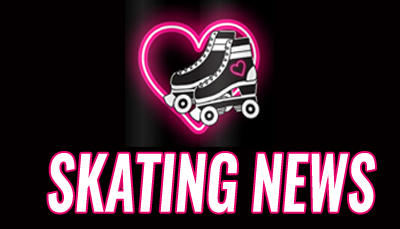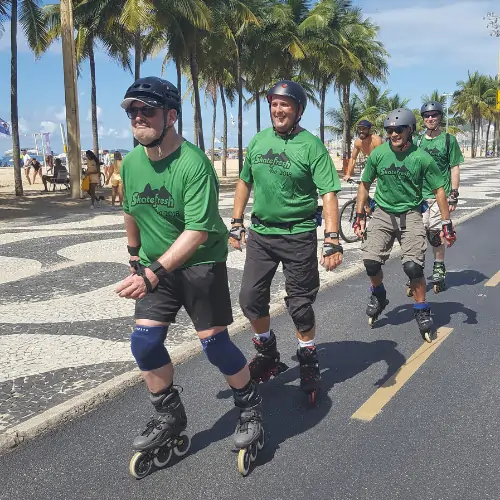Q – “Hi Asha. I am 29. I skated on and off since I was 8 but only recently I got excited and bought a new pair of roller blades. I am trying my best to learn how to push forward in the correct way (not the v shape) and I am also trying to learn how to brake.
But, it seems impossible for me to learn. Are there some people that just can’t skate because of their body, body shape or bad coordination between their mind and body? Skating has been my lifelong dream and so far I haven’t achieved it.
I’d like to hear a true and frank reply. I sincerely appreciate it, because that can save me time and money if I know that skating is just not for me.”
– Michael Tomison (29)
Asha – Thank you for this question Michael and I feel very strongly that I want to encourage you to keep skating and not give up just yet.
Physically I think there are 2 things that every potential skater must be able to do.
- Be able to walk with upright posture.
- Be able to kneel down and tie up your own shoe laces and stand up from that position.
I have only met 3 people in my 20 years teaching career who could not do the second of those 2 things. They were adolescents aged about 14-16 and they were very overweight and could not kneel on the ground and lift one foot in front of them to tie up their skates (they wore slip-on shoes). If you cannot stand up from a one knee on the ground kneeling position, you will not have the basic mobility needed for skating. I have had many, many students in the 70s and even in their 80s who could do these basic movements and so learned to skate.
I believe you can probably do those 2 things right? So let’s move on.
Skating is not like any other thing that the human body does. It’s not like walking, running or cycling or dancing. It is wheels on your feet and all the rules of everything suddenly change and the body is very confused trying to figure out how to feel balanced and safe and until it does so, it will feel tense, scared and anxious (because the body knows there is a risk of pain or injury if you fall and this is true, the risk is real).
Skating correctly is not obvious. The rules that apply to having wheels on your feet do not apply to anything else. They are not easy to “discover” by trial and error. I believe these rules and the specific movements needed to learn to skate (and soon after to stop) must be learned in a systematic and progressive way. Just like how we learn to drive a car. At first driving a car is overwhelming and there’s so many things to think about but with some practice many of those movements become automatic.
The same can be true of skating but only IF it is learned properly, otherwise bad habits develop immediately and these can be very difficult to change later. So it’s worth learning correctly from the start and I can help you do that.
With new beginners on their first skate class we at Skatefresh teach the following skills;
- Doing up skates properly (98% of skaters do not do this in a way that promotes good skating).
- Using protective gear correctly and practicing to fall forwards onto it (and not backwards which is to always be avoided).
- Static practice of different positions on grass or carpet (Ready position, A position, Scissor position, Heel brake position, T position, Lunge position). In each position ‘how to find your balance’ is explained and shown and felt, so that the theory is inside the body and not just in the head as information.
- Static practice of the Basic Stride movement on grass.
- Basic movement in a controlled, slow velocity setting.
- Heel Braking.
Since the beginning of my career I have received thousands of questions like yours about how to skate and it was this stimulus which caused me to go and create online video training courses, exactly for people like you who do not have an instructor or skate school near them to train with.
All the information that we impart in Skatefresh classes is available in video, follow-along format.
I would like to invite you to take advantage of the FREE Beginner level lessons that I can gift you, so you can finally learn properly and not feel discouraged.
I could say something useful like “your weight should be on the front half of your foot when you skate” but if you were to follow the 2 video lessons I’m suggesting below, this sentence would come alive on video and when you follow the instructions you will feel the correct position and then be much more likely to reproduce it on your skates while moving.
On these 2 pages, please click “FREE TRIAL” next to the Trailer video and you will get instant access to these lessons. Almost everything from the list above is covered in these free classes, as if you were in real class with me.
Static Preparations and Basic Movement
https://skatefresh.com/product/how-to-skate-beginner-level-full-course/
I very much hope to hear from you in the near future with some feedback about how you felt watching and following these lessons and what the results were.
Skating takes a lot of focus to reproduce the correct techniques in each moment, but it is this focus which takes us away from our everyday worries and puts us “in the zone” as I call it. This is where the mental benefits happen alongside the strong physical workout that is skating properly.
The images here show you that skaters are all ages and sizes and most of them started in not great physical condition. The video below is of 2 regular Skatefresh clients in their 70’s who I regularly skate with.

I wish you fun in your learning as I believe that overcoming these challenges you’ve encountered will leave you feeling pure joy and a deep sense of accomplishment with yourself. These are the best gifts skating has to offer in the initial months of learning. That’s why I often say;
Skate Well
Feel Alive!



